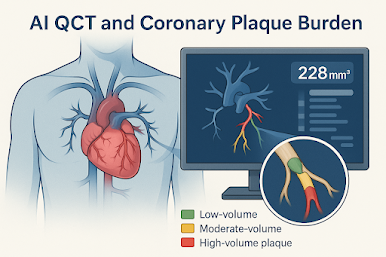Introduction:
Despite decades of progress in the prevention of atherosclerotic cardiovascular disease (ASCVD), disparities persist—particularly in women. A promising innovation, AI-based quantitative computed tomography (AI-QCT), may offer a new solution. Recent results from the CERTAIN study, presented at the 2025 Society of Cardiovascular Computed Tomography (SCCT) meeting, suggest that AI-QCT may not only improve cardiovascular risk stratification but also influence therapeutic decision-making. However, a disconnect remains between AI-based recommendations and actual implementation in clinical practice.
How AI-QCT Is Reshaping Preventive Cardiology
AI-QCT, exemplified by platforms such as Cleerly, automates the quantification of coronary plaque burden from coronary CT angiography (CCTA). It stages plaque by total volume, helping identify high-risk patients earlier. In the CERTAIN study, 700 symptomatic patients from five US centers underwent AI-QCT, which generated personalized medication recommendations.
-
Plaque staging:
-
Stage 0: No plaque (1%)
-
Stage 1: 0–250 mm³ (61%)
-
Stage 2: 250–750 mm³ (28%)
-
Stage 3: >750 mm³ (10%)
-
Physicians were unblinded to AI findings, and 61.6% of patients received new preventive therapy recommendations, most often statins and aspirin.
Real-World Implementation Remains a Barrier
Despite clear AI-guided recommendations, only 29.7% of patients actually initiated new medications by 90 days. The gap was especially wide for:
-
Statins: Recommended for 30.1%, but only 7.7% filled prescriptions
-
Aspirin: Recommended for 35%, with just 4.7% filling them
Importantly, these gaps were consistent across all plaque stages, underlining a system-wide issue in translating risk stratification into treatment.
Persistent Gender Disparities
Although AI-QCT generated similar treatment recommendations for women and men (59.8% vs. 60.9%), women were less likely to receive prescriptions:
-
Prescription fill rate at 90 days:
-
Women: 25.8%
-
Men: 32.7% (P < 0.001)
-
-
Overall uptake of preventive therapies:
-
Women: 43.2%
-
Men: 53.8% (P = 0.031)
-
This suggests a persistent gender gap in cardiovascular care, possibly exacerbated by under-recognition of risk and suboptimal follow-through in clinical settings.
Future Directions and the Role of Patient Engagement
One major limitation of the CERTAIN study is that AI-QCT results were not shared with patients. The study investigators speculate that empowering patients with their own imaging data may enhance treatment adherence and shared decision-making.
Additionally, while AI-QCT shows great promise, standardization across vendors remains a challenge, as different software platforms may yield different plaque volumes. The TRANSFORM study, due to report in 2028, aims to validate how AI-driven tools translate into better clinical outcomes.
Key Takeaways for Clinicians:
-
AI-QCT shows promise in identifying patients at risk of ASCVD and guiding preventive therapy.
-
A significant gap remains between AI-guided recommendations and actual medication use, especially for statins and aspirin.
-
Women are less likely than men to receive prescribed preventive therapies, even when recommended by AI.
-
Patient engagement and standardization of plaque quantification across vendors are critical next steps.
-
Clinicians should consider using AI-QCT outputs in shared decision-making to enhance treatment adherence and outcomes.

No comments:
Post a Comment
Note: Only a member of this blog may post a comment.